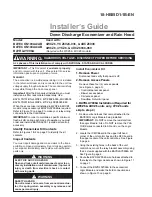
MODEL 396/397
TABLE OF CONTENTS
MODEL 396/397
TABLE OF CONTENTS
MODEL 396/396VP/397/398/398VP
SECTION 4.0
MAINTENANCE
4.0 MAINTENANCE.
The Model 396, 396VP, 397, 398,
and 398VP Sensors are disposable type sensors and
therefore require minimum maintenance. Every sensor
should be kept clean and free of debris and sediment
at all times. The frequency of cleaning by wiping or
brushing with a soft cloth or brush is determined by the
nature of the solution being measured. The sensor
should be removed from the process periodically and
checked in buffer solutions.
SAFETY WARNING
SENSOR IS IN PRESSURIZED SYSTEM!
May cause spray and bodily injury.
Before
removing sensor, be absolutely certain that the
process pressure is reduced to 0 psig and the
process temperature is lowered to a safe level.
If the sensor will not calibrate, refer to your analyzer/
transmitter instruction manual for proper test proce-
dures. If it is determined that the sensor has failed, it
should be discarded and replaced.
4.1 ELECTRODE CLEANING.
If the electrode is coat-
ed or dirty, clean as follows:
1. Remove the sensor from process.
SAFETY WARNING
SENSOR IS IN PRESSURIZED SYSTEM
may cause spray and bodily injury.
Before
removing sensor, be absolutely certain that
the process pressure is reduced to 0 psig
and the process temperature is lowered to a
safe level.
2. Wipe the glass bulb with a soft, clean, lint free cloth
or tissue. If this does not remove the dirt or coating,
go to Step 3. (Detergents clean oil and grease;
acids remove scale.)
3. Wash the glass bulb in a strong detergent solution
and rinse it in clean water. If this does not clean the
glass bulb, go to Step 4.
CAUTION
The solution used during the following check is an acid
and should be handled with care. Follow the directions of
the acid manufacturer. Wear the proper protective equip-
ment. Do not let the solution come in contact with skin or
clothing. If contact with skin is made, immediately rinse
with clean water.
SECTION 4.0
MAINTENANCE
4. Wash the glass bulb in a dilute 5% hydrochloric acid
solution and rinse with clean water. Soaking the sen-
sor overnight in the acid solution can improve clean-
ing action.
NOTE
Erroneous pH results may occur immedi-
ately after acid soak, due to reference junc-
tion potential build-up.
Replace the sensor if cleaning does not
restore sensor operation.
4.2 AUTOMATIC TEMPERATURE COMPENSATOR.
The temperature compensator element is temperature
sensitive and can be checked with an ohmmeter.
Resistance increases with temperature.
The 3K element will read 3000 ohms ±1% at 25°C (77°F)
and a Pt-100 will read 110 ohms. Resistance varies with
temperature for a 3K and Pt-100 element and can be
determined according to Table 4-2 or the following for-
mula:
RT=Ro [l+R1 (T-20)]
Where RT = Resistance
T = Temperature in °C
Refer to Table 4-1 for Ro and R1 values
TABLE 4-1. Ro and R1 Values for
Temperature Compensation Elements
Temperature °C
Resistance (Ohms) ±1%
3K
PT-100
0
2670
100.0
10
2802
103.8
20
2934
107.7
25
3000
109.6
30
3066
111.5
40
3198
115.4
50
3330
119.2
60
3462
123.1
70
3594
126.9
80
3726
130.8
90
3858
134.6
100
3990
138.5
Temperature
Compensation Element
Ro
R1
3K
2934
.0045
PT-100
107.7
.00385
TABLE 4-2.Temperature vs Resistance
of Auto T.C. Elements
29
Содержание 396
Страница 36: ......








































